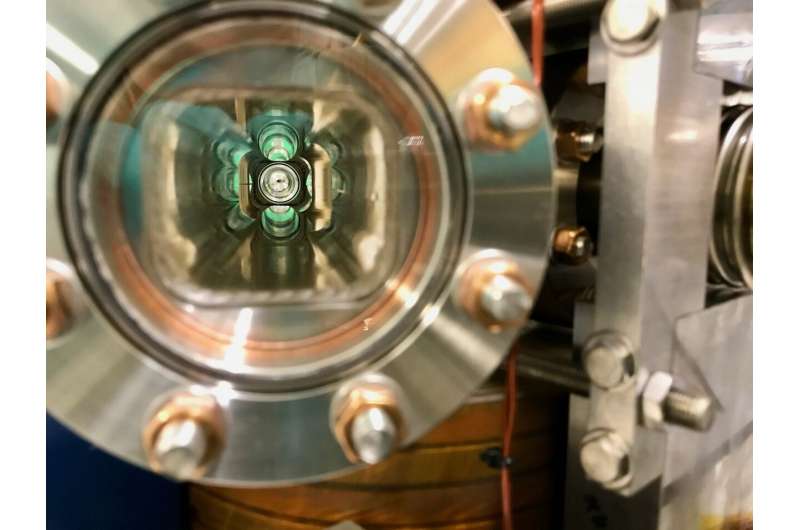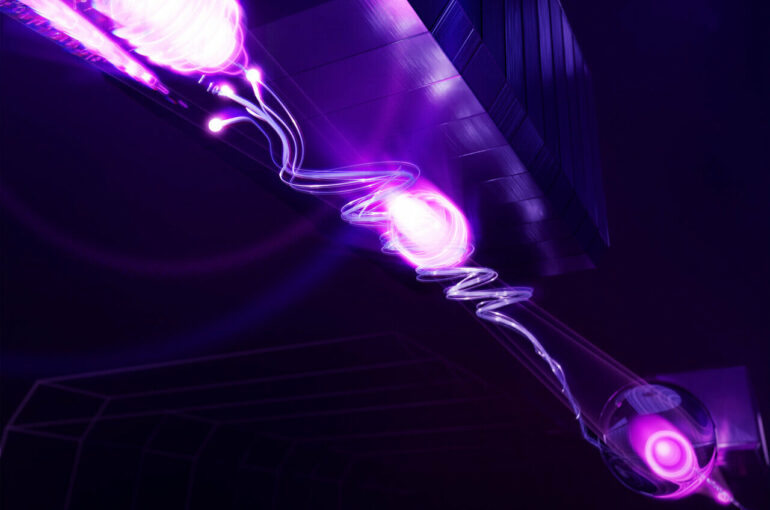Physicists love to smash particles together and study the resulting chaos. Therein lies the discovery of new particles and strange physics, generated for tiny fractions of a second and recreating conditions often not seen in our universe for billions of years. But for the magic to happen, two beams of particles must first collide.
Researchers at the U.S. Department of Energy’s Fermi National Accelerator Laboratory have announced the first successful demonstration of a new technique that improves particle beams. This demonstration could be used in future particle accelerators to potentially use the method to create better, denser particle beams, increasing the number of collisions and giving researchers a better chance to explore rare physics phenomena that help us understand our universe. The team published its findings in a recent edition of Nature.
Particle beams are made of billions of particles traveling together in groups called bunches. Condensing the particles in each beam so they are packed closely together makes it more likely that particles in colliding bunches will interact—the same way multiple people trying to get through a doorway at the same time are more likely to jostle one another than when walking through a wide-open room.
Packing particles together in a beam requires something similar to what happens when you put an inflated balloon in a freezer. Cooling the gas in the balloon reduces the random motion of the molecules and causes the balloon to shrink. “Cooling” a beam reduces the random motion of the particles and makes the beam narrower and denser.
At Fermilab, scientists used the lab’s newest storage ring, the Integrable Optics Test Accelerator, known as IOTA, to demonstrate and explore a new kind of beam cooling technology with the potential to dramatically speed up that cooling process.
“IOTA was built as a flexible machine for research and development in accelerator science and technology,” said Jonathan Jarvis, a scientist at Fermilab. “That flexibility lets us quickly reconfigure the storage ring to focus on different high-impact opportunities. That’s exactly what we’ve done with this new cooling technique.”

The optical stochastic cooling apparatus occupies the entire 6-meter length of IOTA’s long experimental straight. Designed and built by the IOTA/FAST team and industry partners, the system was recently used to achieve the world’s first demonstration of OSC. © Jonathan Jarvis, Fermilab
The new technique is called optical stochastic cooling and this cooling system measures how particles in a beam move away from their ideal course using a special configuration of magnets, lenses and other optics to give corrective nudges.
This kind of cooling system measures how particles in a beam move away from their ideal course and then uses a special configuration of magnets, lenses and other optics to give corrective nudges. It works because of a particular feature of charged particles like electrons and protons: As the particles move along a curved path, they radiate energy in the form of light pulses, giving information about the position and velocity of each particle in the bunch. The beam-cooling system can collect this information and use a device called a kicker magnet to bump them back in line.
Conventional stochastic cooling, which earned its inventor, Simon van der Meer, a share of the 1984 Nobel Prize, works by using light in the microwave range with wavelengths of several centimeters. In contrast, optical stochastic cooling uses visible and infrared light, which have wavelengths around a millionth of a meter. The shorter wavelength means scientists can sense the particles’ activity more precisely and make more accurate corrections.
To prepare a particle beam for experiments, accelerator operators send it on several passes through the cooling system. The improved resolution of optical stochastic cooling provides more exact kicks to smaller groups of particles, so fewer laps around the storage ring are needed. With the beam cooled more quickly, researchers can spend more time using those particles to produce experimental data.
The cooling also helps preserve beams by continually reigning in the particles as they bounce off one another. In principle, optical stochastic cooling could advance the state-of-the-art cooling rate by up to a factor of 10,000.
This first demonstration at IOTA used a medium-energy electron beam and a configuration called “passive cooling,” which doesn’t amplify the light pulses from the particles. The team successfully observed the effect and achieved about a tenfold increase in cooling rate compared to the natural “radiation damping” that the beam experiences in IOTA. They were also able to control whether the beam cools in one, two or all three dimensions. Finally, in addition to cooling beams with millions of particles, scientists also ran experiments studying the cooling of a single electron stored in the accelerator.
“It’s exciting because this is the first cooling technique demonstrated in the optical regime, and this experiment let us study the most the essential physics of the cooling process,” Jarvis said. “We’ve already learned a lot, and now we can add another layer to the experiment that brings us significantly closer to real applications.”

A view looking downstream through the beam pipe of the IOTA ring. The optical stochastic cooling experiment occupies one of the straight sections of the IOTA ring and cools the stored beam, similar to the way radio-frequency stochastic cooling cooled antiprotons in the Recycler during the Tevatron era. © Jamie Santucci, Fermilab
With the initial experiment completed, the science team is developing an improved system at IOTA that will be the key to advancing the technology. It will use an optical amplifier to strengthen the light from each particle by about a factor of 1,000 and apply machine learning to add flexibility to the system.
“Ultimately, we’ll explore a variety of ways to apply this new technique in particle colliders and beyond,” Jarvis said. “We think it’s very cool.”
More information:
Jonathan Jarvis, Experimental Demonstration of Optical Stochastic Cooling, Nature (2022). DOI: 10.1038/s41586-022-04969-7. www.nature.com/articles/s41586-022-04969-7
Provided by
Fermi National Accelerator Laboratory
Citation:
Lab successfully demonstrates new technique to improve particle beams (2022, August 10)



